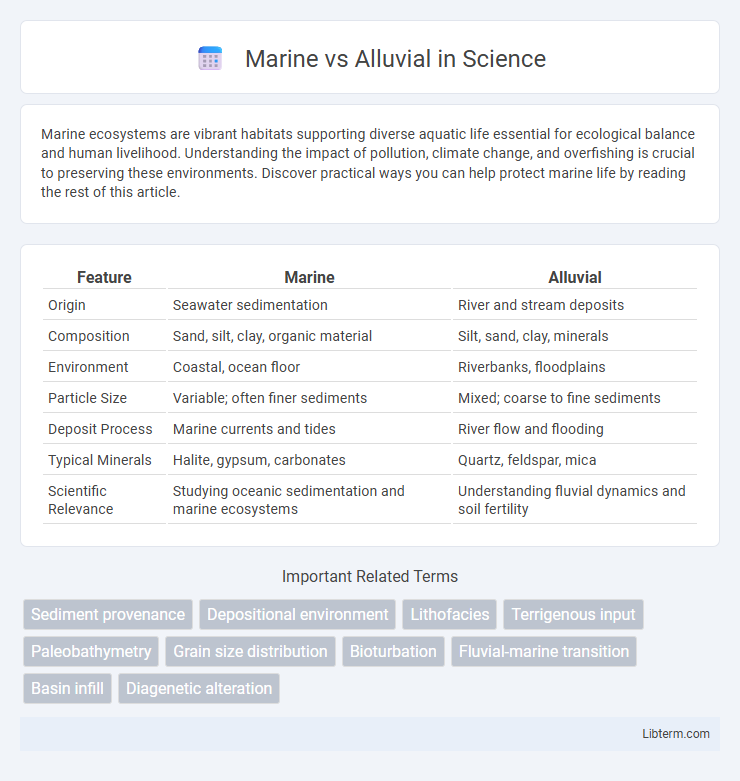Marine ecosystems are vibrant habitats supporting diverse aquatic life essential for ecological balance and human livelihood. Understanding the impact of pollution, climate change, and overfishing is crucial to preserving these environments. Discover practical ways you can help protect marine life by reading the rest of this article.
Table of Comparison
| Feature | Marine | Alluvial |
|---|---|---|
| Origin | Seawater sedimentation | River and stream deposits |
| Composition | Sand, silt, clay, organic material | Silt, sand, clay, minerals |
| Environment | Coastal, ocean floor | Riverbanks, floodplains |
| Particle Size | Variable; often finer sediments | Mixed; coarse to fine sediments |
| Deposit Process | Marine currents and tides | River flow and flooding |
| Typical Minerals | Halite, gypsum, carbonates | Quartz, feldspar, mica |
| Scientific Relevance | Studying oceanic sedimentation and marine ecosystems | Understanding fluvial dynamics and soil fertility |
Introduction to Marine and Alluvial Deposits
Marine deposits form from sediment accumulation in oceanic environments, characterized by fine-grained mud, sand, and organic material influenced by tidal and wave actions. Alluvial deposits arise from river and stream processes, comprising a mix of gravel, sand, silt, and clay transported and laid down by flowing freshwater systems. Both deposit types are crucial for reconstructing past environmental conditions and understanding sedimentary processes.
Definition and Characteristics of Marine Deposits
Marine deposits consist of sediments transported and settled in oceanic environments, primarily consisting of fine-grained materials like clay, silt, and organic matter. These deposits exhibit characteristics such as stratification, high salinity content, and fossilized marine organisms, indicating sedimentation influenced by tides, waves, and currents. In contrast, alluvial deposits are formed by riverine action, characterized by coarser sediments like sand, gravel, and silt, often found in riverbeds, floodplains, and deltas.
Definition and Characteristics of Alluvial Deposits
Alluvial deposits consist of sediments such as sand, silt, clay, and gravel transported and deposited by rivers and streams, forming fertile soil layers in floodplains, deltas, and riverbanks. These deposits are characterized by well-sorted, stratified materials that contribute to rich agricultural lands due to their high nutrient content and water retention capacity. Unlike marine deposits formed by oceanic sedimentation, alluvial deposits result from fluvial processes and typically display varied grain sizes reflecting fluctuating water flow velocities.
Formation Processes: Marine vs Alluvial
Marine formations result from sediment deposition primarily influenced by oceanic processes such as wave action, tides, and currents, leading to layers of sand, silt, and organic material along coastlines and continental shelves. Alluvial formations are created through the accumulation of sediments transported by rivers and streams, typically forming fertile floodplains, deltas, and alluvial fans due to the mechanical weathering and erosion upstream. The distinct formation processes highlight marine environments as sediment sinks influenced by saline water dynamics, whereas alluvial environments depend on freshwater flow and sediment load variability.
Geographical Distribution: Marine and Alluvial Environments
Marine environments dominate coastal and oceanic regions, characterized by saltwater ecosystems found along seashores, continental shelves, and deep ocean basins. Alluvial environments occur primarily in river valleys, floodplains, and deltaic regions, where sediments are deposited by freshwater rivers and streams. These distinct geographical distributions influence sediment composition, nutrient availability, and habitat types in marine versus alluvial settings.
Sediment Composition: Marine vs Alluvial
Marine sediments primarily consist of biogenic materials such as calcium carbonate from shell fragments, silica from diatoms, and clay minerals transported by ocean currents, reflecting a mixture of biological and inorganic components. Alluvial sediments are predominantly composed of terrigenous materials including sand, silt, clay, and gravel, derived from weathering and erosion of continental rocks and transported by river systems. The mineralogical and granulometric characteristics of alluvial sediments vary widely depending on the source area, while marine sediments display more uniformity influenced by oceanic conditions and biological productivity.
Economic Importance and Applications
Marine sediments hold significant economic importance due to their rich deposits of minerals such as polymetallic nodules, which are crucial for extracting valuable metals like manganese, nickel, and cobalt used in electronics and renewable energy technologies. Alluvial sediments are vital for agriculture and construction industries as they contain nutrient-rich soils that support crop production and provide sand and gravel essential for infrastructure development. Both sediment types contribute to diverse applications, from resource extraction and environmental management to land reclamation and industrial raw materials.
Environmental Impact and Sustainability
Marine deposits often lead to saltwater intrusion and habitat disruption, negatively affecting coastal ecosystems and biodiversity. Alluvial soils, formed by river sediments, typically promote fertile land conducive to agriculture but can cause erosion and sedimentation issues impacting freshwater habitats. Sustainable management of marine and alluvial environments requires balancing resource extraction with ecosystem preservation to mitigate environmental degradation.
Key Differences Between Marine and Alluvial Deposits
Marine deposits form in oceanic environments and are primarily composed of fine sediments like clay and silt transported by seawater, whereas alluvial deposits develop in riverine settings, characterized by coarser materials such as sand, gravel, and pebbles transported by flowing freshwater. Marine sediments often contain fossils of marine organisms, along with abundant salts and organic matter, while alluvial deposits are typically richer in varied mineral content due to erosion from diverse terrestrial sources. The depositional processes differ significantly: marine deposits result from sediment settling in calm, saline aquatic environments, contrasting with the dynamic, high-energy fluvial processes shaping alluvial fans and floodplains.
Conclusion: Choosing Between Marine and Alluvial Resources
Choosing between marine and alluvial resources depends largely on the specific material needs, environmental impact considerations, and economic feasibility. Marine resources, sourced from seabeds, often offer minerals like polymetallic nodules and marine sands rich in rare metals, while alluvial resources, deposited by rivers, typically provide gold, diamonds, and other heavy minerals in accessible sediment layers. Assessing extraction technologies, site location, and sustainability practices ensures an informed decision aligned with conservation and profitability goals.
Marine Infographic

 libterm.com
libterm.com